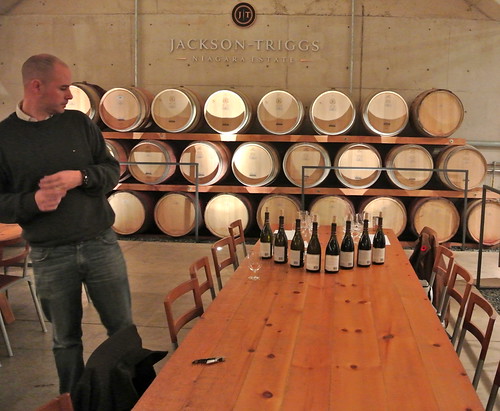
It did not shock me when Constellation Brands and Bordeaux’s Groupe Taillan announced this fall that they were parting ways on the Osoyoos Larose project in the Okanagan Valley.
Groupe Taillan, owners of Chateau Gruaud Larose, paid an undisclosed sum to joint venture partner Constellation to acquire 100% of the project’s brand name, viticultural and winemaking team, and 32 hectares of vineyards planted to Bordeaux varietals in the Okanagan.
It was a project that was started by Vincor Canada and Taillan to produce a world-class Bordeaux-style red wine on the West Coast, a good partner for the already created
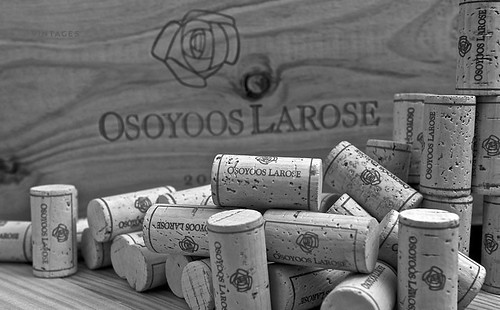
Le Clos Jordanne, a Burgundy-inspired brand in Niagara that was established between Vincor and Boisset in France.
When Vincor was sold to Constellation Brands, the fear was always that the small, boutique brands such as Osoyoos Larose and Le Clos Jordanne would be buried under the bigger brands in the Canadian Portfolio — Jackson-Triggs and Inniskillin.
The two partnerships didn’t exactly fit comfortably into the new reality.
With a both a jewel in the Okanagan and Niagara, Constellation was book-ended with some of the top juice produced in Canada in the regions the two styles worked best. A Bordeaux-style red blend and top-notch, single-vineyard Pinot Noirs and Chardonnays that seldom fail to impress vintage to vintage in both the Okanagan Valley and Niagara.

It was envisioned and executed with Old World partners by a veteran gang of Vincor founders and skeptics feared that vision would die with the takeover by Constellation.
With Osoyoos now gone from the portfolio, can Le Clos Jordanne be far behind?
I truly hope not, and there are no obvious signs that this is the case, but I can see Constellation wanting to tap into those impeccable vineyards that have made Le Clos such an iconic brand. It would be tempting to take that exquisite fruit that make up the single-vineyard wines of Le Clos and direct it to the more profitable Jackson-Triggs family of wines.
The Le Clos brand has been trimmed down the past couple of vintages and long gone are the splashy release parties to showcase each new vintage. The grand vision for a Frank Gehry designed winery in the centre of the vineyard was long ago abandoned and the wine continues to be made in a non-descript building situated unglamorously alongside the QEW while the wines are sold at the Jackson-Triggs retail store at the winery.
One look at the website, horribly outdated, and you can see that the marketing department has more important issues to deal with.

One thing that hasn’t changed with the Le Clos wines, is the attention to detail and the full commitment from winemaker Sebastien Jacquey to stay true to the original vision — to fuse tradition and innovation with passion and expertise to create wines that exemplify the distinct Niagara terroir while offering utmost quality among the world’s finest Pinot Noirs and Chardonnays.
I have tasted the wines of Le Clos through each and every vintage since its inception, first with winemaker Thomas Bachelder and now with Jacquey. Both are pragmatic winemakers, always deferring to the vineyard for inspiration and style and maintaining a sense of consistency as the vines mature.
If you tasted every vintage of Le Clos side by side, I don’t think you’d see a break from style and that’s a testament to both Jacquey and Bachelder who share the same values of minimal intervention in the winery and respect for the terroir where the grapes are grown.
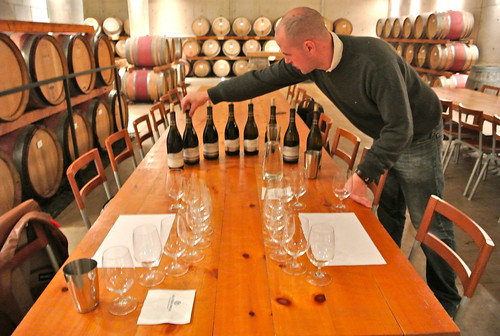
I tasted the 2011 wines with Jacquey in the cellars of Jackson-Triggs about a month ago.
The vintage for both Pinot and Chard in Niagara was humming along in the latter stages of the summer with good phenolic ripeness in the grapes. But, right at harvest in early September, the rains came. Lots and lots of rain.
There was no way to avoid it. The grapes were ripe for the picking at 22-23 Brix and Jacquey was left to harvest what he could between downpours. The key was to keep the grapes dry, which he did in tents, and then slow down the sorting table to make sure only the healthiest grapes made it through for pressing.
Careful sorting was done in the vineyard as well as on the sorting table. Jacquey says he lost about 5-7% of fruit through the sorting process.
With all the rain, Jacquey feared it was “going to be a very bad year. But it turned out pretty good,” he said.
Here’s what we tasted (all wines now available at Jackson-Triggs winery in Niagara-on-the-Lake or online).
The Pinot Noirs
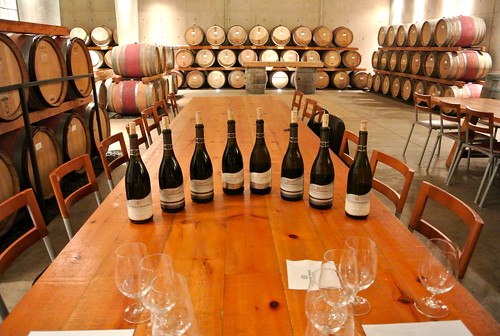
Le Clos Jordanne Village Pinot Noir 2011 ($30, 88 points) — A nose of sour cherry, cedar, tobacco, raspberry bush and bramble. There is some structure on the palate with fresh acidity to go with raspberry-cherry and cassis notes that are a bit shy at the moment. I would suggest that this was a touch closed when I tasted it.
Le Clos Jordanne Claystone Terrace Pinot Noir 2011 ($40, 90 points) — Claystone is the coolest of the Le Clos vineyards and is generally picked last. There is ripeness on the nose with black cherry, raspberry, sweet oak spice, crushed leaves and earthy, wet-stone notes. It is youthful and energetic on the palate with ripe red fruits, grippy tannins, spice and touches of licorice, green tobacco and lively acidity. Needs time to loosen up the tight structure, but will reward once it opens up.
Le Clos Jordanne Les Clos Vineyard Pinot Noir 2011 ($40, 91 points) — The main Le Clos vineyard tends to be warmer and riper with slightly higher alcohol (typically 13.5% vs. 13%) so Jacquey uses a bit more (35%) new French oak for roundness. The nose displays intense red fruits, violets, sweet oak and wet earth, spice and subtle cassis and pipe tobacco. The highly extracted fruit on the palate shows a fatter, rounder style of Pinot than, say, the Claystone, with tannic structure and a more muscular feel through the finish.
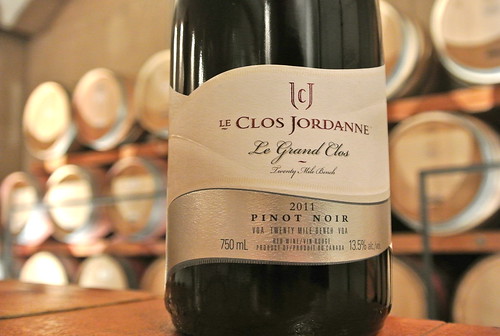
Le Clos Jordanne Le Grand Clos Pinot Noir 2011 ($70, 93 points) — Jacquey likes to think of his top Pinot as a “Grand Cru” in Niagara. It is made up of the best lots from the Le Clos Jordanne Vineyard, generally from the western edge of the vineyard. The nose shows highly extracted black cherry, juicy raspberry, boysenberry, mocha spice, and wet stone minerality. It is highly structured and needs time to fully show its stuff but still reveals concentrated (without being austere) fruit flavours on the palate, firm tannic structure (from the fruit rather than the oak), dry extract and firm acidity, oak spice and minerals. It’s highly extracted, yes, says Jacquey: “Did I go too far? It’s powerful, maybe,” he says, “but I wanted to find out.” Buy, hold and watch this beauty spread her wings.
The Chardonnays
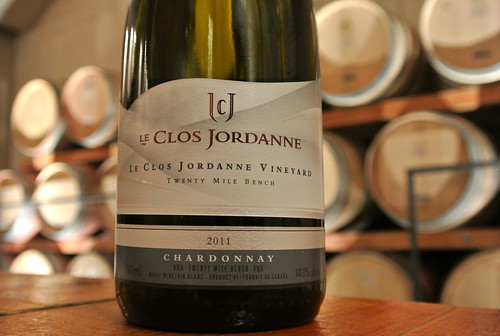
Le Clos Jordanne Village Reserve Chardonnay 2011 ($30, 92 points) — This is the arguably the best “Village” Chardonnay to emerge from the Le Clos portfolio to date. The Chardonnay grapes were a little less affected by the rains and benefited from a near-perfect growing season for Chardonnay. Such an expressive nose of bright, ripe fruit and subtle oak stylings. Look for poached pear, apple, and lemon cream pie on the nose to go with freshness, stony minerality and lightly toasted spices. With the oak in check, the stone fruits shine on the palate to join the subtle minerality all in near-perfect balance.
Le Clos Jordanne Claystone Terrace Chardonnay 2011 ($40, 92 points) — Claystone Terrace is contiguous with the top Le Clos Jordanne Vineyard yet turns out wines that are profoundly different. The clay and limestone soils of Claystone help shape the wines that are the most distinct, in my opinion, of the Le Clos portfolio both in the Chards and Pinot Noirs. For 2011, only 10-15% new oak was used for aging with no fining at all. The nose is already rockin’ with McIntosh apple, lemon tart, apricot, soft spice and subtle toast and vanilla. It is a substantive Chardonnay on the palate with weight and power but not at the expense of poise and elegance. The apple-pear fruit melds gorgeously with tropical notes and citrus zest through a lively finish that combines a delicious core of oak and vanilla toast with stony minerality. It is a beautifully integrated wine already with room to improve further with some bottle age.
Le Clos Jordanne Le Clos Jordanne Vineyard Chardonnay 2011 ($40, 91 points) — The goal for Jacquey on this single-vineyard Chard was “structure on the mid-palate without being oaky.” Only 15% new French oak was used, a downward trend that we are seeing more and more in Niagara. The nose is not as overt as with the Claystone, but the apple and pear fruit play nice with the spice and minerality. It is pretty and poised on the palate with lovely stone fruits, subtle spice and racy acidity that leads to a long, lively finish.
Le Clos Jordanne Le Grand Clos Chardonnay 2011 ($65, 92 points) — Jacquey dials the oak down to 10% new in the top cuvee to better showcase the “natural concentration of fruit” from the best parcels of grapes from Le Clos Jordanne Vineyard. “We can still use the oak we need for the mid-palate,” he says. “It’s a much better way to differentiate Niagara from other regions.” The nose shows persistent apple, peach and lovely citrus notes with subtle minerality and soft oak spice offered up as gorgeous accents. This Chardonnay is all about the play of rich fruit, integrated spice and swirling minerality that’s bolstered and balanced by fresh acidity. A lovely drop from beginning to end.





Comment here